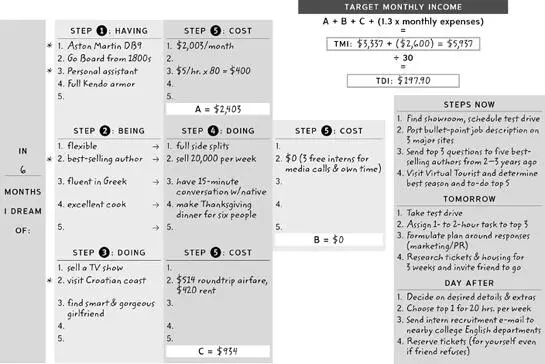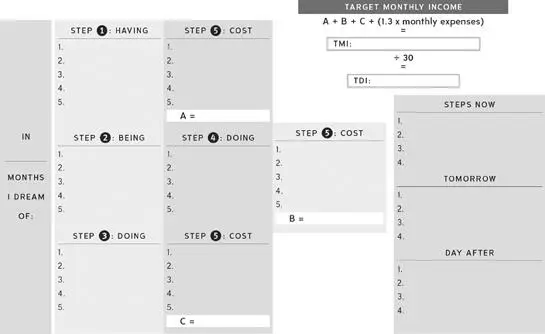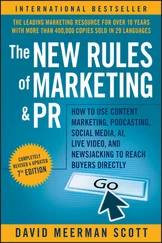Timothy Ferriss - The 4-Hour Workweek - Escape 9–5, Live Anywhere, and Join the New Rich - Expanded and Updated
Здесь есть возможность читать онлайн «Timothy Ferriss - The 4-Hour Workweek - Escape 9–5, Live Anywhere, and Join the New Rich - Expanded and Updated» весь текст электронной книги совершенно бесплатно (целиком полную версию без сокращений). В некоторых случаях можно слушать аудио, скачать через торрент в формате fb2 и присутствует краткое содержание. Жанр: Прочая научная литература, на английском языке. Описание произведения, (предисловие) а так же отзывы посетителей доступны на портале библиотеки ЛибКат.
- Название:The 4-Hour Workweek: Escape 9–5, Live Anywhere, and Join the New Rich - Expanded and Updated
- Автор:
- Жанр:
- Год:неизвестен
- ISBN:нет данных
- Рейтинг книги:3 / 5. Голосов: 1
-
Избранное:Добавить в избранное
- Отзывы:
-
Ваша оценка:
- 60
- 1
- 2
- 3
- 4
- 5
The 4-Hour Workweek: Escape 9–5, Live Anywhere, and Join the New Rich - Expanded and Updated: краткое содержание, описание и аннотация
Предлагаем к чтению аннотацию, описание, краткое содержание или предисловие (зависит от того, что написал сам автор книги «The 4-Hour Workweek: Escape 9–5, Live Anywhere, and Join the New Rich - Expanded and Updated»). Если вы не нашли необходимую информацию о книге — напишите в комментариях, мы постараемся отыскать её.
The 4-Hour Workweek: Escape 9–5, Live Anywhere, and Join the New Rich - Expanded and Updated — читать онлайн бесплатно полную книгу (весь текст) целиком
Ниже представлен текст книги, разбитый по страницам. Система сохранения места последней прочитанной страницы, позволяет с удобством читать онлайн бесплатно книгу «The 4-Hour Workweek: Escape 9–5, Live Anywhere, and Join the New Rich - Expanded and Updated», без необходимости каждый раз заново искать на чём Вы остановились. Поставьте закладку, и сможете в любой момент перейти на страницу, на которой закончили чтение.
Интервал:
Закладка:
Great cook  make Christmas dinner without help
make Christmas dinner without help
Fluent in Chinese  have a five-minute conversation
have a five-minute conversation
with a Chinese co-worker
4. What are the four dreams that would change it all?
Using the 6-month timeline, star or otherwise highlight the four most exciting and/or important dreams from all columns. Repeat the process with the 12-month timeline if desired.
5. Determine the cost of these dreams and calculate your Target Monthly Income (TMI) for both timelines.
If financeable, what is the cost per month for each of the four dreams (rent, mortgage, payment plan installments, etc.)? Start thinking of income and expense in terms of monthly cash flow—dollars in and dollars out—instead of grand totals. Things often cost much, much less than expected. For example, a Lamborghini Gallardo Spyder, fresh off the showroom floor at $260,000, can be had for $2,897.80 per month. I found my personal favorite, an Aston Martin DB9 with 1,000 miles on it, through eBay for $136,000—$2,003.10 per month. How about a Round-the-World trip (Los Angeles  Tokyo
Tokyo  Singapore
Singapore  Bangkok
Bangkok  Delhi or Bombay
Delhi or Bombay  London
London  Frankfurt
Frankfurt  Los Angeles) for $1,399?
Los Angeles) for $1,399?
For some of these costs, the Tools and Tricks at the end of Chapter 14 will help.
Last, calculate your Target Monthly Income (TMI) for realizing these dreamlines. This is how to do it: First, total each of the columns A, B, and C, counting only the four selected dreams. Some of these column totals could be zero, which is fine. Next, add your total monthly expenses x1.3 (the 1.3 represents your expenses plus a 30% buffer for safety or savings). This grand total is your TMI and the target to keep in mind for the rest of the book. I like to further divide this TMI by 30 to get my TDI—Target Daily Income. I find it easier to work with a daily goal. Online calculators on our companion site do all the work for you and make this step a cinch.
Chances are that the figure is lower than expected, and it often decreases over time as you trade more and more “having” for once-in-a-lifetime “doing.” Mobility encourages this trend. Even if the total is intimidating, don’t fret in the least. I have helped students get to more than $10,000 per month in extra income within three months.
Sample Dreamline

Dreamline
(Go to www.fourhourblog.com for larger printable worksheets and online calculators.)

Dreamline Math—Another Good Option
There could be a different way of handling monthly and one-time goals. I’ll use your example of an Aston Martin’s monthly payment, a personal assistant’s monthly payment, and a trip to the Croatian coast. While the first two should certainly be totaled and included in your target monthly income, the trip is something that should be divided by the number of months between now and the dreamline’s total time.
Thus if you had a six-month dreamline:
Aston Martin = 2,003 per month
Personal assistant = 400 per month
Croatian trip = 934 total, and thus 934/6 per month
Right now in the book and in the spreadsheet we have (2003 + 400 + 934) x1.3 monthly expenses = Target Monthly Income (or TMI).
But I think it should be (2003 + 400 + 934/6 x1.3 monthly expenses = TMI.
Or, more generally: [Monthly Goals + (One-Time Goals / Total Months)] x1.3 monthly expenses = TMI.
—JARED, president, SET Consulting
6. Determine three steps for each of the four dreams in just the 6-month timeline and take the first step now .
I’m not a big believer in long-term planning and far-off goals. In fact, I generally set 3-month and 6-month dreamlines. The variables change too much and in-the-future distance becomes an excuse for postponing action. The objective of this exercise isn’t, therefore, to outline every step from start to finish, but to define the end goal, the required vehicle to achieve them (TMI, TDI), and build momentum with critical first steps. From that point, it’s a matter of freeing time and generating the TMI, which the following chapters cover.
First, let’s focus on those critical first steps. Define three steps for each dream that will get you closer to its actualization. Set actions—simple, well-defined actions—for now, tomorrow (complete before 11 A.M.) and the day after (again completed before 11 A.M.).
Once you have three steps for each of the four goals, complete the three actions in the “now” column. Do it now. Each should be simple enough to do in five minutes or less. If not, rachet it down. If it’s the middle of the night and you can’t call someone, do something else now, such as send an e-mail, and set the call for first thing tomorrow.
If the next stage is some form of research, get in touch with someone who knows the answer instead of spending too much time in books or online, which can turn into paralysis by analysis. The best first step, the one I recommend, is finding someone who’s done it and ask for advice on how to do the same. It’s not hard.
Other options include setting a meeting or phone call with a trainer, mentor, or salesperson to build momentum. Can you schedule a private class or a commitment that you’ll feel bad about canceling? Use guilt to your advantage.
Tomorrow becomes never. No matter how small the task, take the first step now!
COMFORT CHALLENGE
The most important actions are never comfortable.
Fortunately, it is possible to condition yourself to discomfort and overcome it. I’ve trained myself to propose solutions instead of ask for them, to elicit desired responses instead of react, and to be assertive without burning bridges. To have an uncommon lifestyle, you need to develop the uncommon habit of making decisions, both for yourself and for others .
From this chapter forward, I’ll take you through progressively more uncomfortable exercises, simple and small. Some of the exercises will appear deceptively easy and even irrelevant (such as the next) until you try them. Look at it as a game and expect some butterflies and sweat—that’s the whole point. For most of these exercises, the duration is two days. Mark the exercise of the day on your calendar so you don’t forget, and don’t attempt more than one Comfort Challenge at a time.
Remember: There is a direct correlation between an increased sphere of comfort and getting what you want.
Here we go.
Learn to Eye Gaze (2 days)
My friend Michael Ellsberg invented a singles event called Eye Gazing. It is similar to speed dating but different in one fundamental respect—no speaking is permitted. It involves gazing into the eyes of each partner for three minutes at a time. If you go to such an event, it becomes clear how uncomfortable most people are doing this. For the next two days, practice gazing into the eyes of others—whether people you pass on the street or conversational partners—until they break contact. Hints:
Читать дальшеИнтервал:
Закладка:
Похожие книги на «The 4-Hour Workweek: Escape 9–5, Live Anywhere, and Join the New Rich - Expanded and Updated»
Представляем Вашему вниманию похожие книги на «The 4-Hour Workweek: Escape 9–5, Live Anywhere, and Join the New Rich - Expanded and Updated» списком для выбора. Мы отобрали схожую по названию и смыслу литературу в надежде предоставить читателям больше вариантов отыскать новые, интересные, ещё непрочитанные произведения.
Обсуждение, отзывы о книге «The 4-Hour Workweek: Escape 9–5, Live Anywhere, and Join the New Rich - Expanded and Updated» и просто собственные мнения читателей. Оставьте ваши комментарии, напишите, что Вы думаете о произведении, его смысле или главных героях. Укажите что конкретно понравилось, а что нет, и почему Вы так считаете.












